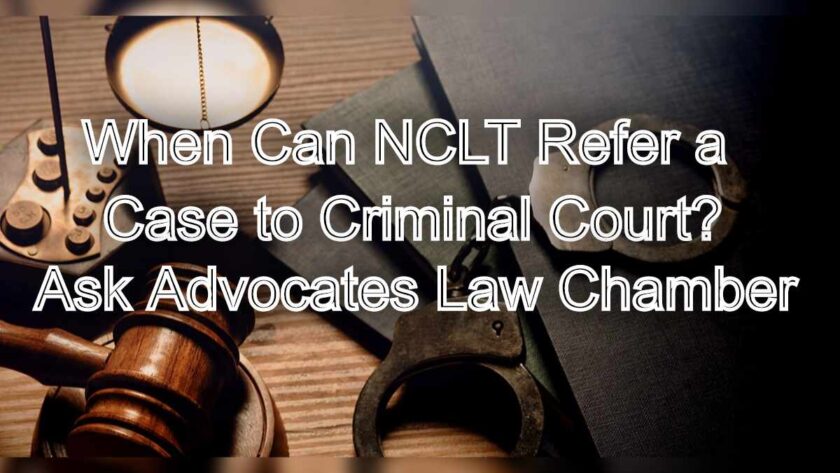When Can NCLT Refer a Case to Criminal Court? – As advocates at Ask Advocates Law Chamber, we know the intricacies of corporate law and the NCLT. Therefore, we understand how a case moves from a civil tribunal to a criminal court. This transition is not automatic, because the National Company Law Tribunal (NCLT) is a quasi-judicial body with specific powers. Consequently, its primary jurisdiction is civil in nature. The NCLT mostly handles corporate disputes, insolvency proceedings, and company law matters. However, certain situations arise where the NCLT can initiate a referral. When faced with serious misconduct, the NCLT can take a stern action. This article explains when NCLT can refer a case to a criminal court.
Understanding the NCLT’s Jurisdiction
First, we must appreciate the NCLT’s legal framework. The NCLT derives its authority from the Companies Act, 2013 and the Insolvency and Bankruptcy Code, 2016 (IBC). Primarily, it deals with civil issues like corporate restructuring, mergers, demergers, and resolution of insolvency. Therefore, its adjudicatory role is to ensure corporate governance and financial stability. By and large, it is not a criminal court. As a result, it lacks the power to convict individuals or impose criminal sentences like imprisonment. Nevertheless, its proceedings can uncover evidence of criminal wrongdoing. This is where the referral power becomes relevant.
The Legal Provisions for Referral
The power to refer a case to a criminal court is not explicitly stated as a general provision in the NCLT’s founding acts. Instead, this power is a necessary corollary to its existing powers. Moreover, it is specifically invoked when certain offences are committed. For example, Section 340 of the Code of Criminal Procedure, 1973 (CrPC) becomes the key instrument. This section empowers a court, or in this case a tribunal, to hold a preliminary inquiry. After the inquiry, if the tribunal believes an offense has been committed, it can make a formal complaint. Ultimately, this complaint is sent to a Magistrate with jurisdiction.
Offences that Trigger a Referral
To illustrate, several offences under the Indian Penal Code (IPC) can lead to an NCLT referral. Most importantly, these are offences committed in relation to or during NCLT proceedings. For instance, perjury is a common offence. This means giving false evidence or a false declaration under oath. Another example is forgery, where a party submits fake documents to the tribunal. Furthermore, fraudulent activities, such as transferring assets to defraud creditors, are also grounds for a referral. Consequently, the NCLT takes these matters very seriously.
The Role of the IBC in Criminal Matters
The Insolvency and Bankruptcy Code also provides specific grounds for criminal prosecution. For example, under Section 66 of the IBC, the NCLT can hold a director or partner personally liable. This happens if they carry on the business of the corporate debtor with fraudulent intent. Subsequently, the NCLT may pass an order to make them contribute to the corporate debtor’s assets. Also, if a person initiates a fraudulent insolvency process, they face penalties under Section 65 of the IBC. Similarly, there are criminal provisions for a resolution professional. If they fail to perform their duties, they can be prosecuted. Thus, the IBC itself creates a pathway for criminal action.
The Procedure for Referral
The procedure is meticulous. First and foremost, a party or the tribunal itself must bring the matter to light. The tribunal then initiates a preliminary inquiry. During this process, it considers all the evidence. Furthermore, it determines if it is expedient in the interest of justice to proceed. This is a crucial legal test. Assuming it finds a prima facie case, the tribunal prepares a written complaint. This complaint outlines the facts and the alleged offences. Next, the complaint is forwarded to the appropriate Magistrate or Special Court. The Magistrate then takes cognizance of the offence. From that moment on, the criminal court’s jurisdiction begins.
Fraud as a Primary Cause
Fraudulent actions are perhaps the most compelling reason for a referral. A resolution professional may uncover a complex web of transactions. These transactions might be designed to siphon off money. For instance, a director might create fake invoices. They might also sell company assets at undervalue. In such cases, the NCLT must act. It cannot simply impose civil penalties. Therefore, it must invoke its ancillary powers to combat such malfeasance. The NCLT’s ability to refer such cases ensures that individuals cannot use corporate insolvency as a shield for their criminal acts.
NCLT’s Limitations and Judicial Discipline
It is important to remember the NCLT is not a criminal court. Its powers are limited. For example, it cannot arrest individuals. It cannot conduct a full criminal trial. Ultimately, it only acts as the body that sets the criminal legal process in motion. This distinction is vital for maintaining judicial discipline. A single bench of the NCLT may decide to refer a case. Conversely, the National Company Law Appellate Tribunal (NCLAT), or even the Supreme Court, may later review this decision. The entire process is subject to checks and balances.
Frequently Asked Questions
No, the NCLT cannot directly imprison an individual. Its jurisdiction is primarily civil and quasi-judicial. The NCLT can, however, refer a case involving criminal offenses like fraud or perjury to a criminal court. ⚖️
The NCLT can refer a case to a criminal court when it finds evidence of offenses committed in relation to or during its proceedings. These offenses are typically defined under the Indian Penal Code, such as perjury (giving false evidence), forgery (submitting fake documents), and various types of fraudulent activities designed to cheat creditors or other stakeholders. 📝
No, a referral does not automatically mean a person is guilty. The NCLT’s referral is merely the first step. It signifies that the tribunal has found a prima facie case of criminal wrongdoing. The criminal court then takes cognizance of the complaint and conducts its own trial.
The NCLT’s power to refer a case to a criminal court is not a general provision in its founding acts. Instead, it is a power that is derived from Section 340 of the Code of Criminal Procedure, 1973. This section allows a court or tribunal to hold a preliminary inquiry and, if it believes an offense has been committed, to make a formal complaint to a Magistrate. 📜
The IBC has specific provisions that deal with fraudulent conduct and can lead to criminal prosecution. For example, under Section 66 of the IBC, the NCLT can hold directors liable for fraudulent trading. The NCLT may pass an order to make them contribute to the company’s assets. This can then be followed by a formal complaint to a criminal court for the associated criminal offenses. 🔗
Conclusion: A Powerful Ancillary Function
In conclusion, the NCLT has a significant and powerful ancillary function. It can refer cases to a criminal court. This happens when it finds evidence of serious offences. Consequently, this power is a deterrent against corporate misconduct. It ensures that perpetrators of fraud cannot escape justice by merely hiding behind civil proceedings. At Ask Advocates Law Chamber, we believe this power is essential. It upholds the rule of law. It also protects the interests of stakeholders. The NCLT’s role extends beyond corporate law. It plays a key role in the fight against economic crime.
Read More
- Oppression and Mismanagement Cases in NCLT – A Legal Roadmap
- IBC Cases in Chennai NCLT: What Creditors and Debtors Must Prepare For
- Industrial Pollution & Environmental Clearance Violations: A Guide to NGT Proceedings
- Suspension of Government Servants: CAT Case Strategies That Work
- How NGT is Shaping Chennai’s Lakes, Marshlands, and Coastal Projects
- National Company Law Tribunal (NCLT)



